Before we start, do you know what a Cajon is? Or a box drum? If you’re searching for the best Cajon drums, I assume you do.
Nevertheless, if for some reason you don’t, let’s start by talking about the history of the Cajon and what made it one of the most popular percussion instruments of the modern world.
Firstly, the Cajon (pronounced as ka – hone) is the Spanish word for box, which makes it pretty easy to understand why they decided to name it Cajon in the first place.
The instrument has been a central piece of traditional Afro-Peruvian music since, at least, the 19th century.
It originated in colonial Peru out of necessity because, at one point, their masters felt threatened and forbade slave drums.
During that period, moved by the power of music, they instead used old fruit crates or upside-down drawers to play their rhythms.
Nowadays, the Cajon acts as a seat because it’s practical and because they also did so back in the day.
Thanks to the fear of punishment for playing a musical instrument, as a disguise, they used the Cajon as a seat.
The Cajon itself is a six-sided wooden box, with the front panel, called tapa, made from thinner wood, while the other sides provide the structure. There’s also a hole cut into the back panel, where the sound comes out.
How you play the Cajon didn’t change much since then. You sit on top of it and slap your hands near the edge to produce a higher pitch sound, similar to the snare drum.
If you want a lower pitch sound, like the bass drum, you slap the center instead. You can also slap the box in different areas to produce different sounds, it’s up to you.
How did the Cajon reach worldwide popularity?
In the middle of the 19th century, the Cajon gained popularity and spread throughout the world, to other Spanish colonies.
Later, during the 20th century, they also served as an instrument for the unprivileged in Cuba.
Just like in Peru, a hundred years earlier, Fidel Castro’s communist government forbid drums and music in general that were nothing more than a way to gather larger crowds.
Similarly to the Peruvian slaves, Cuban resisters used fruit crates and whatever they could find instead.
In the ‘70s, during one of his visits to Peru, the master of the flamenco guitar, Paco de Lucia, was exposed to the Cajon for the first time.
Since flamenco includes a lot of clapping and rhythmic stamping, and it was common for the guitarist to beat the body of their instrument, Paco considered the Cajon the instrument that could do it all.
To summarize, that was enough for him to bring the Cajon back with him and start a new era of flamenco, later known as flamenco fusion.
At this time, the modern-day Cajon didn’t change much when compared to the traditional Peruvian one.
Eventually, a few modern versions included some modifications like snare wires, guitar strings as well as some basic electronics, but that’s about it.
With this in mind, now that we know the history of the Cajon and how its popularity spread all over the world, here are the best Cajon drums:
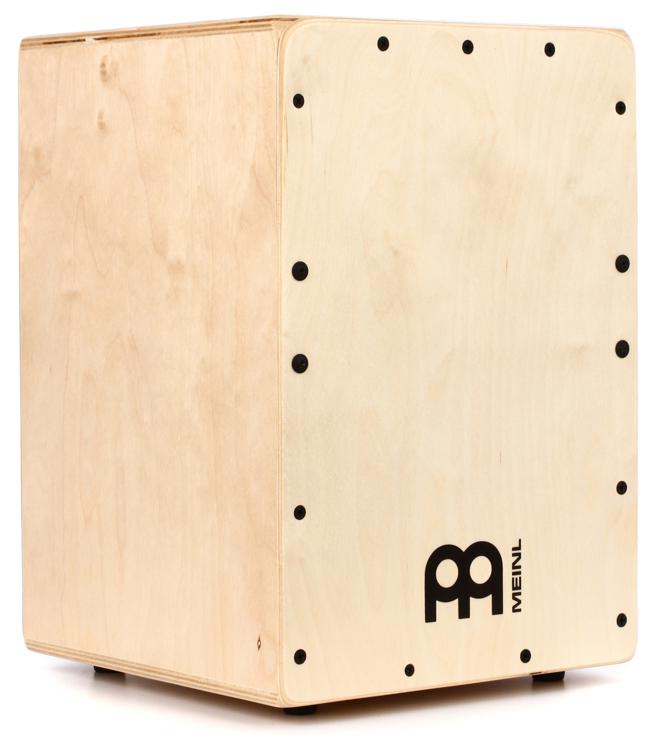 Today I’m starting the article with the entry-level, budget-friendly option: the Meinl JC50B.
Today I’m starting the article with the entry-level, budget-friendly option: the Meinl JC50B.
Besides being cheaper than the average Cajon, it’s also smaller considering the sizes are 15″ x 10.5″ x 10.25″.
As i have noted, it’s probably not ideal for anyone above 5.9”, but on the other hand, it’s easy to carry around between acoustic gigs due to being small and lightweight.
Additionally, the Cajon is made of Baltic Birch and includes dual internal fixed snare wires that rest against the inside of the front plate.
They improve sensitivity and provide a snare-type of sound when slapped near the top corners of the playing surface.
The low-end punch that emulates the bass drum sound can be achieved by striking the center of the front plate.
On the other hand, with such a small size, the bass tone is probably the weakest one I’ve heard coming from a Cajon, which means you’ll need a microphone for most gigs.
As expected from a basic Cajon, it features the resonant hole at the back of the Cajon, and four rubber feet to increase the grip and allow the body to resonate freely.
Furthermore, you can adjust the front plate by loosening or tightening the top corners screws to achieve different sounds.
To conclude, if you’re a beginner, someone on a budget or simply too short for bigger Cajons, the Meinl Jam Series Cajon is your best bet.
Sure, it doesn’t have some of the fancy things premium Cajons do, but it’s cheaper than most and therefore, provides a great price/quality ratio.
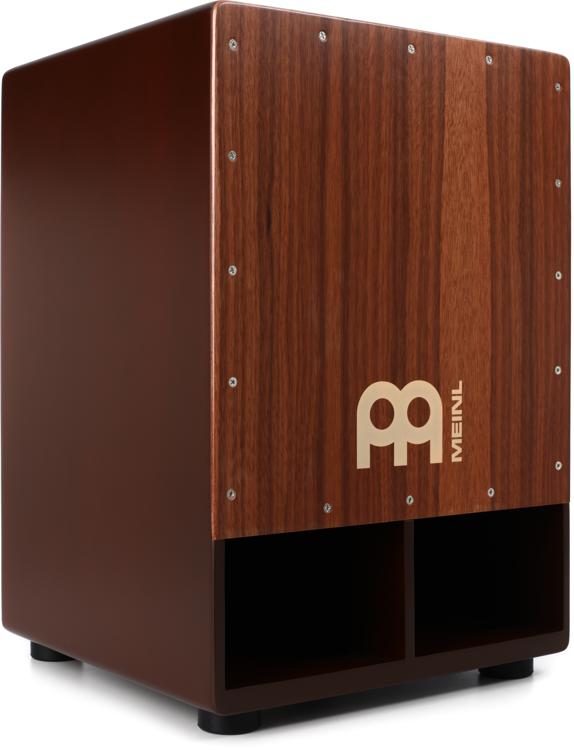 My second recommendation comes from Meinl, a brand that rose like a phoenix in the past decade or two.
My second recommendation comes from Meinl, a brand that rose like a phoenix in the past decade or two.
They did so by producing some of the best cymbals and percussion instruments currently on the market.
All things considered, the Subwoofer Cajon is a great example of Meinl’s superior innovation and build quality they recently got us used to.
It features a forward projecting sound port, instead of the traditional hole on the back wood panel. That projects your beats directly towards the audience instead of backward.
In addition, there’s also an internal reflex channel that mimics the way a subwoofer boosts the low end in a speaker setup. Meinl likes to call it a mechanical subwoofer.
For amplification purposes, you can place a microphone in front, or inside, one of the ports, just like you would do with any bass drum.
Inside you find two fixed sets of snares, that react well to soft playing like ghost notes and finger rolls.
Additionally, you can also find adjustable top corners, one handle at the back to facilitate transportation, and a rugged top without any cushion.
This Cajon in particular is made out of a mix of Walnut (front plate) and eco-friendly medium-density fiberboard (MDF). The walnut provides a good balance between all frequencies and creates an open sound full of warmth and depth.
With 19.75″ x 13.75″ x 13.5″, the Jumbo Bass Cajon is bigger than the average and produces unique, deep sounds that can take over any performance.
To summarize, the Meinl Jumbo Bass Subwoofer Cajon isn’t cheap, and not as easy to carry around as some of the alternatives, but what it brings to the table fully justifies it.
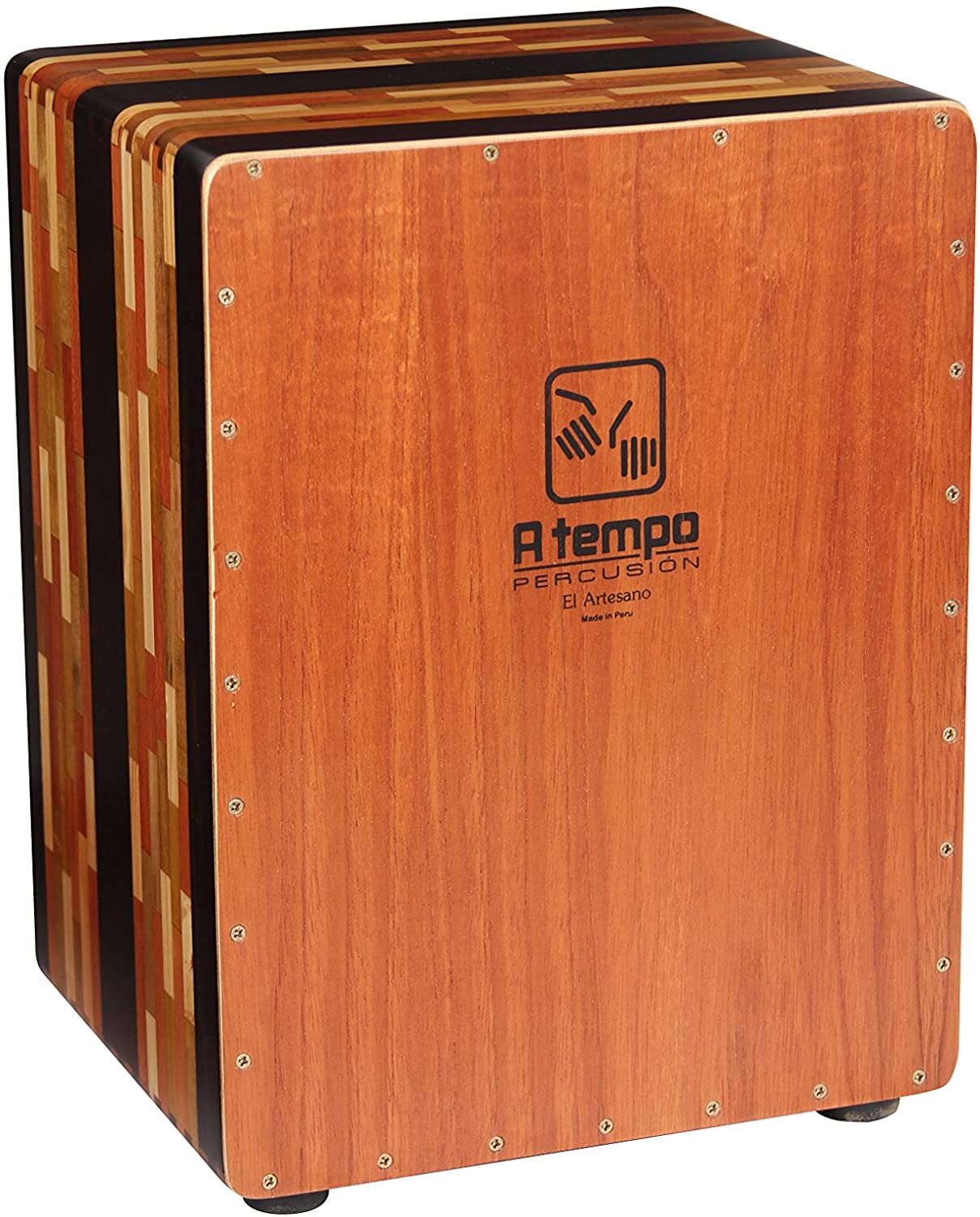 As we’ve seen before, Cajon’s history goes all the way back to Peru, where it all started.
As we’ve seen before, Cajon’s history goes all the way back to Peru, where it all started.
For example, A Tempo Percussion is a Peruvian business that specializes in designing and manufacturing wooden percussion instruments, like the Cajon.
El Artesano is a masterpiece, thanks to its eye-catching looks as well as the mix of the sound characteristics of both the traditional Cajon and the flamenco one.
It’s handmade with a few pieces of solid Mohena, tropical Walnut, Peruvian Lapuna, and American Muswood on the side panels.
In addition, the “Tapa” (the batter side of the Cajon) on the other hand, is made of Spanish Cedar. It is then built with dovetail joints and finished with a durable furniture-grade finish
The Cajon itself is 18.5” x 13.5” x 12″, which we consider pretty standard, and features snare wires inside.
The wires are placed in a way that aims to reduce their interference when playing the bass, without sacrificing the expected snap when playing the “snare”.
To clarify, that technique gives it the perfect balance between the traditional and the flamenco Cajon, providing a warm bass, as well as a snappy slap tone.
It comes with four anti-slip rubber feet, as well as a specially tailored travel bag to safely carry it from gig to gig.
To conclude, if you’re looking for a classic, handmade Cajon that’s as good looking as it’s practical, “El Artesano” should be your top priority.
 The next one on the list comes from Pyle, a company founded in the ‘60s that produced high-quality woofers.
The next one on the list comes from Pyle, a company founded in the ‘60s that produced high-quality woofers.
By the year 2000, they went through a massive transformation and expanded into different markets, including musical instruments.
For example, one of the musical instruments is the Pyle String Jam Cajon, made out of birch, the same durable wood used in many professional drum kits.
It weighs only 10.9 pounds and comes in a compact size – 18″ x 12″ x 12″. That makes it easy to carry around, unlike some of the heavier and bulkier alternatives.
In addition, inside you find two sets of adjustable guitar strings that you can tune (hex key included) from the bottom of the Cajon.
In other words, that’s enough to differentiate it from the rest since all the previous ones used snare wires instead. Neither is better, it all comes down to personal preference.
There are four rubber feet at the bottom to make sure the Cajon doesn’t slip and to avoid any vibration that might interfere with the sound produced.
The bass tone is probably where this Cajon disappoints the most. There isn’t a clear distinction between the snare and bass tone as we would hope for, thanks to the weak bass tone.
Overall, if you’re looking for a cheap Cajon and the Meinl Jam Series isn’t your thing, the Pyle String Cajon is a cheap and reliable alternative.
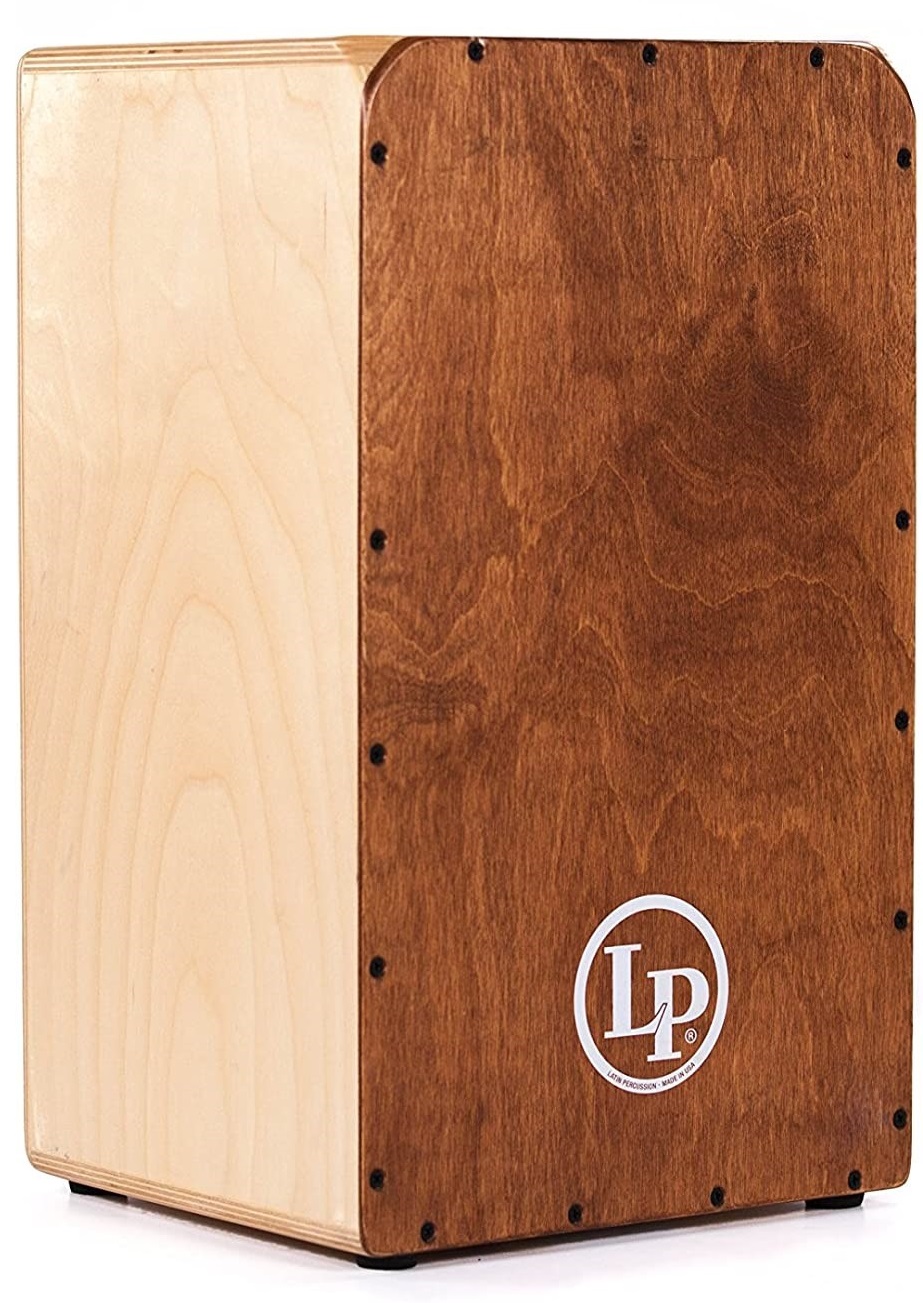 I couldn’t make a list of the best Cajons in the market, without including one from the powerhouse of percussion instruments.
I couldn’t make a list of the best Cajons in the market, without including one from the powerhouse of percussion instruments.
Latin Percussion makes some of the best percussion instruments used by many professional musicians, including bongos, cowbells, and of course, Cajons.
Firstly, the Americana Groove Wire is 18.5” x 11” x 10.25”, which makes it the second smallest Cajon on the list, so far.
From the body to the front plate, it’s constructed entirely with hand-select Baltic Birch, which makes it extremely durable and sensitive.
Additionally, you can adjust the front plate to achieve a different tone by tightening or loosening the screws.
It features rounded corners to increase comfort while playing, and four rubber feet to prevent the Cajon from slipping on most surfaces and to help the body resonate well.
Like most Cajons on the list, it includes internal snare wires to achieve that typical snare sound and a hole on the back that you can use to mic it up.
Unfortunately, the wires are not adjustable, which means you won’t be able to adjust the tone to your liking and have to work with what you get.
The good news is the fact that you can easily distinguish between the snare and bass tones, unlike the Pyle String Jam Cajon.
Overall, this is a good Cajon, since it provides one of the best price-quality ratios. It isn’t the most versatile, but it provides a good sound mixed with even better looks at a considerably fair price.
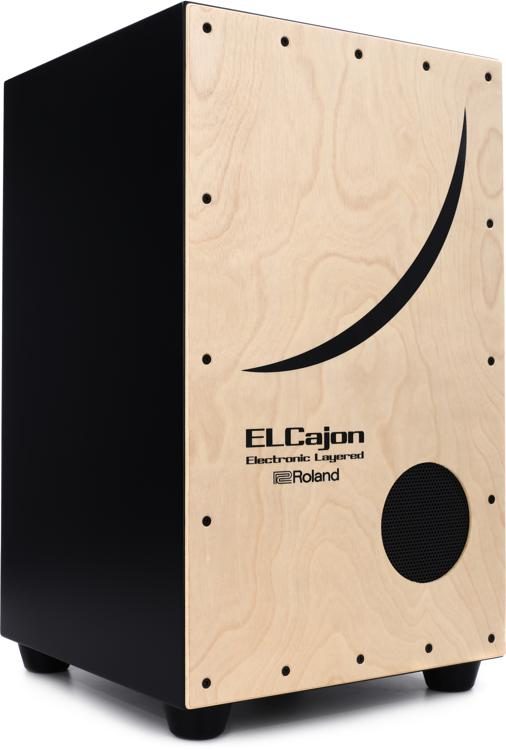 What we’ve seen so far, is more or less the same, besides a couple of small differences, like different wood types and guitar strings instead of snare wires.
What we’ve seen so far, is more or less the same, besides a couple of small differences, like different wood types and guitar strings instead of snare wires.
Roland is a Japanese manufacturer of electronic musical instruments. Most drummers agree that they make the best electronic drum kits, by far.
It was only a matter of time until they designed and produced an electronic Cajon. They finally did it and called it the Roland ELCajon EC-10.
The electronic part of the EC-10 makes it unique and versatile, thanks to the new layer of sounds it includes.
On its own, the acoustic Cajon sounds decent, but no more than that. It’s 19.5” x 11.75” x 11.625”, with a Sapele Plywood front plate and a Medium Density Fiberboard (MDF) body.
What distinguishes it from the rest?
FIrstly, it comes with 30 sounds, including 10 studio Cajons to enhance the acoustic one, 10 percussion sounds including tambourine and djembe, and 10 SFX sounds, like the TR-808 snare.
In the EC-10, you can find two sound controls: one on top of the Cajon and one on the back. The one on top allows you to scroll through sound categories and select a kit within a category.
In addition, the panel on the back, on the other hand, allows you to access the power switch, change the volume and the trigger balance.
That kind of versatility lets you balance between the head and hedge sounds and adjust the trigger sensitivity to match your playing style.
Not to mention, if that wasn’t already enough, the EC-10 features an integrated amp and coaxial speaker, to make sure you’re heard no matter the conditions.
You can opt to power it with a regular AC adaptor or use 6 AA alkaline batteries instead, that last between 6h and 12h, depending on the type of use.
There’s also an audio jack on the back to plug in a smartphone or any music player in general and use it as a speaker.
However, if you’re ready to add it to your basket, let me warn you that it’s kind of expensive, but totally worth it, in my humble opinion. It’s not that much more expensive than the high-end Cajons while bringing way more to the table.
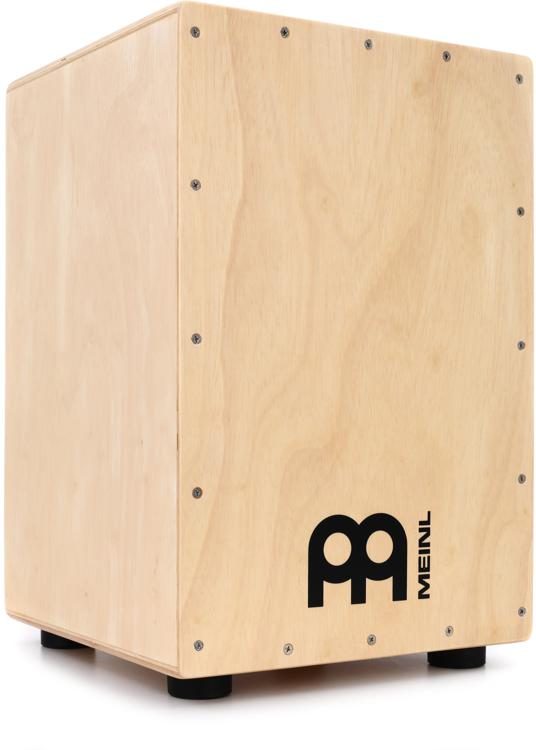 After the previous impressive piece of technology, it’s time to get back to the basics.
After the previous impressive piece of technology, it’s time to get back to the basics.
There’s no better way to do it than with a traditional Siam Oak instrument like the Meinl Headliner String Cajon.
Its sizes are 18″ x 12.25″ x 11.75″ and it delivers the classic flamenco Cajon tones thanks to the internal fixed strings.
Additionally, you can adjust the sizzle effect of the micro-coiled steel strings (similar to guitar strings) with an (included) hex key to achieve the snare tone you like the most. You do it by turning the two screws located at the bottom of the Cajon.
In similar fashion, the front plate top corners are fully adjustable since you can change the distance between the body and the front plate to mess with the percussive slap you get while slapping the corners.
It’s also thin enough to respond well to soft finger rolls, ghost notes, and even brush playing, without losing any durability.
Like most Cajons, it comes with four rubber feet to prevent it from slipping and to let it freely resonate.
There’s also a regular 5” circular rear port to allow airflow to escape while playing, and it’s the perfect spot to place a microphone when you need extra amplification.
The Headliner series consists of three Cajons with different wood types: siam oak, stained American white ash, and maple.
To conclude, there’s not much to add when it comes to the Meinl HCAJ1NT. It’s a good all-around Cajon that provides a great balance between bass and snare tones and enough versatility thanks to a couple of adjustments available.
More importantly, it’s one of the cheapest instruments in the whole article, providing an impressive value for such a low price.
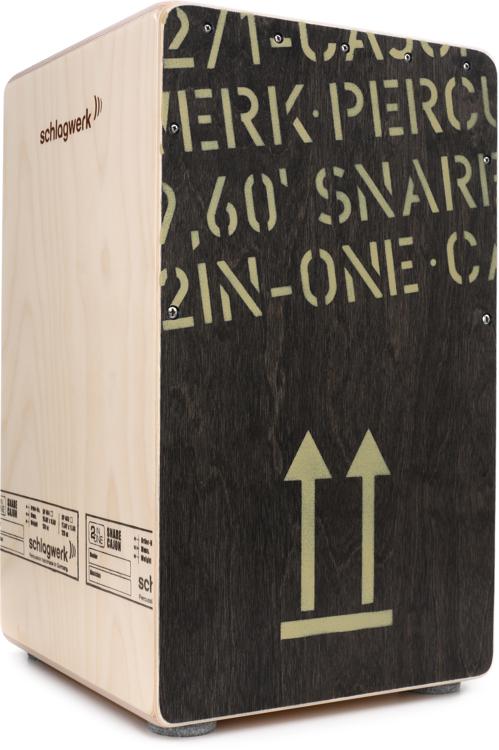 My next suggestion comes from a completely different brand called Schlagwerk. Don’t ask me what it means!
My next suggestion comes from a completely different brand called Schlagwerk. Don’t ask me what it means!
The owners started as apprentices in a small barn in 1982, and two years later they developed their first Cajon.
Fast forward and almost thirty years later, they are one of the most well-respected Cajon manufacturers in the world.
Firstly, the “2inOne” is a full-sized Cajon with 19.75” x 11.75” x 11.75” which makes it the tallest Cajon in the whole list.
Constructed with 8 plies of birch, it provides a warm sound and enough durability to survive most gigging conditions.
This model in particular has a darker birch playing surface which gives it a unique and industrial look that stands out from the rest.
Additionally, inside you can find 40 snares that press against the “Tapa” at a precisely defined angle. The snares are removable, but not adjustable, allowing you to switch between the classic dry sound or the Flamenco style.
Just like most Cajons, it comes with a rear hole for a deeper bass tone (or amplification purposes) and four felt feet that might not be as durable as we would hope for.
In the end, this is a perfectly balanced Cajon with the option to switch between the Peruvian and the Flamenco version while providing different sizes and colors to choose from.
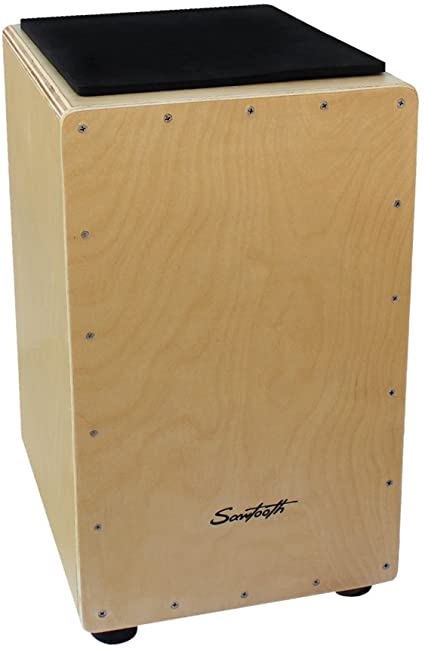 Sawtooth is far from well known in the music industry, but they build everything from guitars and pianos to percussion instruments, like the Cajon.
Sawtooth is far from well known in the music industry, but they build everything from guitars and pianos to percussion instruments, like the Cajon.
The ST-CJ120B model aims at beginners, or someone on a tight budget that are looking for a decent quality, affordable product.
It’s well-built from top to bottom with birch wood and its dimensions are 19.5” x 11.6” x 11.8” which is considered standard nowadays.
Overall, the wood choice and dimensions provide an increased attack mixed with a brighter tone.
All things considered, sound-wise, it’s far from perfect, since Sawtooth Cajon is less responsive than we could hope for. Plus, the snare tone drowns the bass tone, making it harder to distinguish between the two.
Just like most Cajons, you can change how it sounds with the adjustable internal snare wires and the adjustable front plate.
Besides all that, the Cajon also comes with a padded seat cushion for added comfort during extended sessions and durable rubber feet.
Additionally, there’s a hole on the back of the Cajon to amplify its natural sound, and Sawtooth includes a decent carry bag so you can safely store, or carry it around.
To conclude, this is a great Cajon considering the price you pay. I can’t even comprehend how the seller builds, ships, and includes a carrying bag for less than $60.
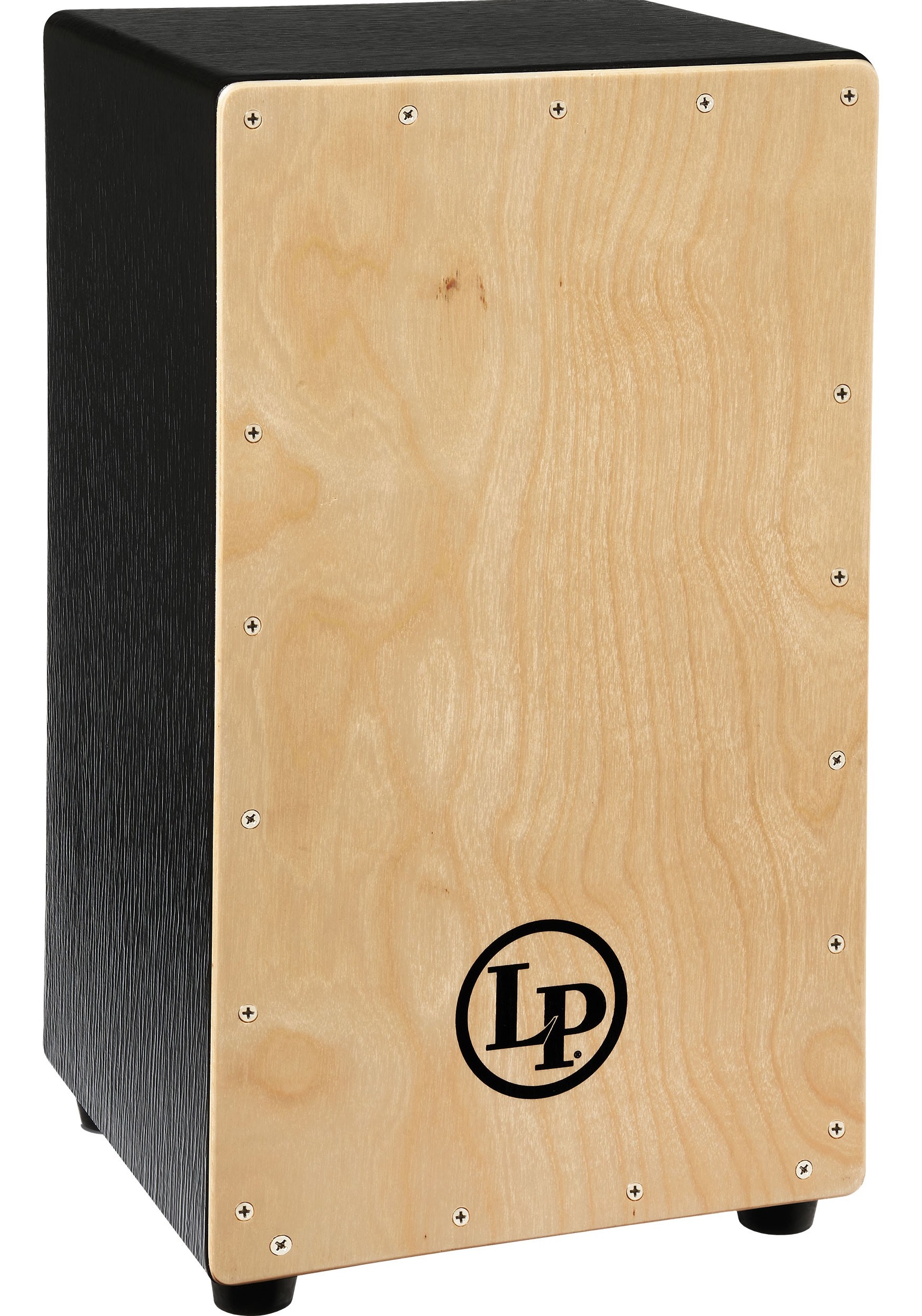 My last suggestion comes from Latin Percussion, one of the most popular percussion instruments’ manufacturers.
My last suggestion comes from Latin Percussion, one of the most popular percussion instruments’ manufacturers.
For example, they build anything from congas to Cajons and this one in particular own DRUM! Magazine’s Drummies! award for Best Cajon.
The Black Box is 19” x 11” x 10” which is fairly standard and big enough for an average-sized individual.
Latin Percussion used a combination of Baltic Birch/Poplar to build the soundboard which provides a punchy, warm, and musical tone.
On the other hand, the body is built with MDF and finished with a beautiful matte black that distinguishes this Cajon from the rest. I haven’t played one long enough, but MDF’s durability is something everyone should be wary about.
Either way, the LP1428NYN version features a non-adjustable natural faceplate, so you won’t be able to adjust it to match your taste. Considering we’ve seen plenty of even cheaper Cajons with an adjustable faceplate, this is a disappointment.
In addiction, you can’t adjust the internal snare wires either which completely removes their tunability.
Either way, the wires paired with the resonant hole at the back offer plenty of projection for both the snare and bass tones
Overall, if you like the black look and value a somewhat environmentally responsible instrument with a small footprint, the LP Black Box is the way to go.
Final Words
The Cajon is a really fun instrument to play and I’m really glad it gained a lot of popularity in the past few years.
For that reason, with the increased popularity, manufacturers flood the market with different models including ones with front-facing resonant holes and electronic Cajons.
Nowadays, if the acoustic gig is too small, I don’t even bother bringing in an acoustic kit, the Cajon is more than enough.
To summarize, if you’re looking for your first Cajon, the A Tempo Percussion El Artesano Cajon is the best all-around, thanks to its classic look, sound, and impressive build quality. The LP Americana Groove Wire Cajon is a close second.
The Meinl Jumbo Bass Subwoofer Cajon offers the best bass and build quality, while the Roland ELCajon EC-10 adds a new layer to anyone that finds standard Cajons boring.
In the end, I hope this article achieved its main purpose of educating you on the history of the Cajon, its many different types, and which are the best Cajon drums for your needs.

